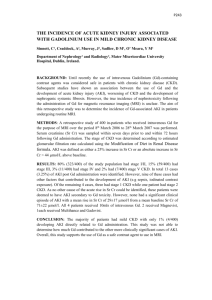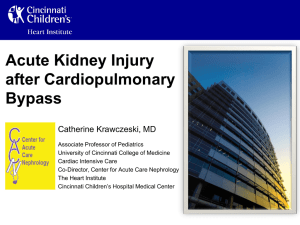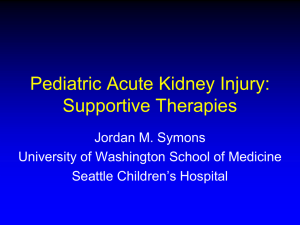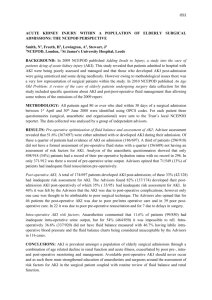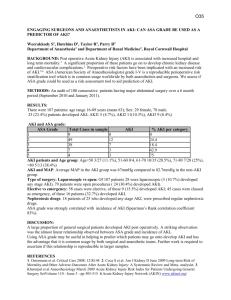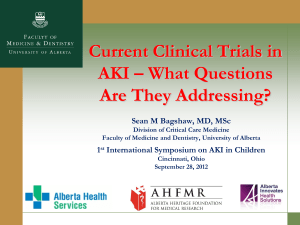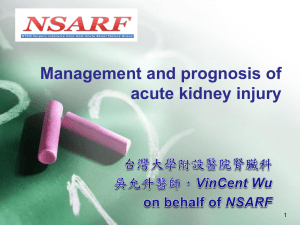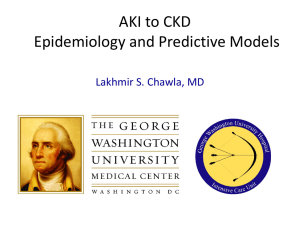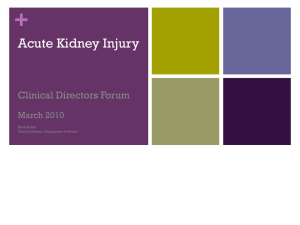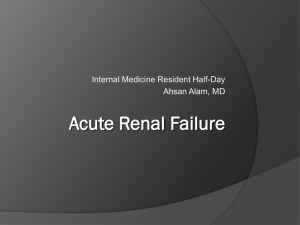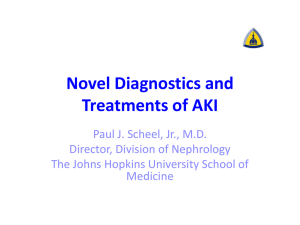AKI itself Epidemiology
advertisement
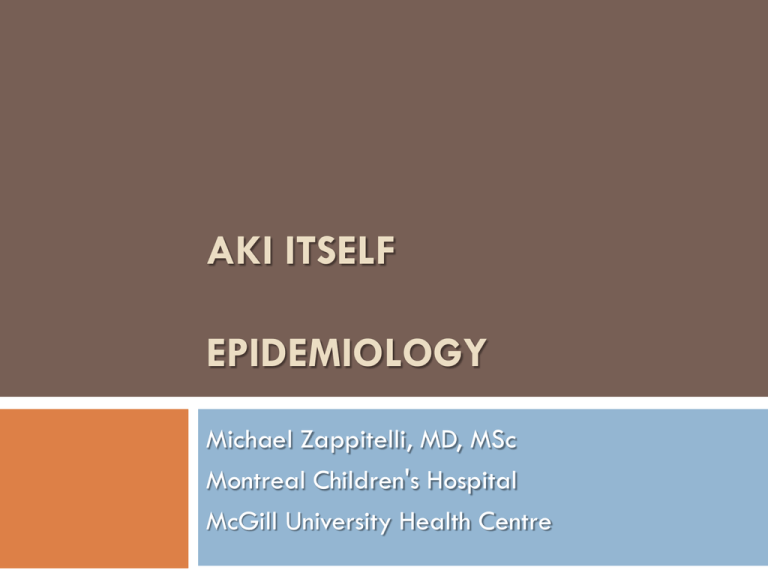
AKI ITSELF EPIDEMIOLOGY Michael Zappitelli, MD, MSc Montreal Children's Hospital McGill University Health Centre Epidemiology: Distribution and patterns of Health-events Health-characteristics Their causes, determinants or influences in welldefined populations AKI Who, What, When, Where, Why and How? Past: Pediatric AKI studies Mostly studies of RRT requirement: rare Small Retrospective Poor outcome Lack of understanding of severity spectrum Pediatric acute RRT is not easy! Studies on acute RRT technique Pediatric RRT refinement Experience description Past: Pediatric AKI studies Pre-2004: Descriptions of specific diagnoses HUS Malaria Glomerulonephritis Bee stings!! Changes with Era's HUS: >25% to ~15% Heme-Onc: 8 to ~18% Sepsis:No change (~1/5) Williams et al, Arch Ped Adolesc Med, 2002 Changes with Era's Williams et al, Arch Ped Adolesc Med, 2002 Moghal et al, Clin Nephrol 1998 UK, 1984-1991 52% of AKI referred cases either HUS or “primary renal disease” Most patients requiring RRT: “primary renal disease” DEFINITIONS Pediatric AKI – around the world! AKI or AKI recognition may be increasing Vachvanichsanong et al, Pediatrics, 2006 THAILAND Overview Epidemiology Today Studies using recent definitions Incidence Characteristics, patterns Outcomes, mortality Highlighting: Different regions Studies reporting RRT need Incidence Characteristics Mortality Diagnostic populations AKI- using definitions X X Goodbye Incidence: PICU full cohort studies USA N=3396 No severe CKD Creat Turkey N=189 No severe CKD Creat Kayaz et al, Acta Pediatr, 2012 Schneider et al, Ped Crit Care, 2010 Incidence: PICU partial cohort studies Canada N=2106 ≥12 hours Creat USA N=150 Vent and/or Vaso, Foley Urine Alkandari Creat et al, + Crit Care, 2011 Plotz et al, Intens Care Med, 2008 North India Netherlands N=486 N=189 >24≥4 hours, Vent days NO severe Admx Creat Urine AKI South+India Creat N=215 >48 hours Creat + Urine Mehta, et al, Ind Ped, 2012 Ackan-Arikan, Ped Crit Care, 2007 Krishnamoorthy, et al, Ind J Ped, 2012 Incidence: Cardiac 2 Canadian studies (646) Morgan, j Ped, 2012 Zappitelli, KI, 2009 4 US studies (1594) Manrique, Ped Anesth, 2009 Li, Crit Care Med, 2011 Aydin, Ann Thorac Surg, 2012 Blinder, J Thor Card Surg, 2012 1 Hungarian study (1510) Toth, Card Anethes, 2012 1 Indian study (124) Sethi, Clin Exp Nephrol, 2011 Incidence: Nephrotoxins Vancomycin ≥2 days N=167 Aminoglycosides ≥5 days N=557 100 100 80 80 Increasing numbers (≥3) 60 of NTM used pRIFLE creat Increases risk for AKI in 40 non-ICU children 20 Moffett & Goldstein, CJASN, 2011 60 40 20 0 No AKI R I F Zappitelli et al, NDT, 2011 ~pRIFLE creat 0 No AKI AKI McKamy et al, J Peds, 2012 ? independent of ICU/other drugs? Smyth et al, Thorax, 2008 Case-control study, CF 24 AKI (UK CF Database) IV Aminoglycoside independent RF Incidence: Stem cell transplant & other cancers Most commonly expressed as SCr doubling Generally determined 30-100 days post Range from 5 to 40%! Many nephrotoxins, critical illness, sepsis Better understanding of AKI spectrum needed RRT-requiring AKI X X Goodbye Incidence of D-AKI Cardiac surgery: 0 to 31%! ~1% ~6% 5-6% ~1-3% 1-2% ~4% PD>> others RRT-AKI Mortality high everywhere (almost!) 50-60% 25-50% 42-67% 52-77% 40-45% 40% 33-65% 64% 36% 11% Characteristics, patterns AKI due to other causes >>> primary renal disease Developing countries: More importance of primary renal disease, Malaria, HUS However, now secondary causes emerging “TOP HITS” around room: “ATN” “Hypovolemia” Sepsis Nephrotoxic medication – almost always significant when looked at!! Heme-Onc Cardiac surgery Majority have multiple organ dysfunction Characteristics, patterns Characteristics, patterns AKI OCCURS EARLY Distribution of the day of admission that subjects reached pRIFLEmax (n=123) and pRIFLE F stratum (n=31). Confirmed in several other larger epidemiologic cohort studies Outcome associations In repeated studies last 5 years: AKI independently associated with PICU mortality Length of stay Duration of mechanical ventilation Graded response: Stage 1 worse than 2 worse than 3 A few studies: associated with higher costs Difficult to REALLY know if independent of illness severity Importance of all these studies Paradigm changed PAST Only severe AKI, requiring RRT is of serious significance. AKI is a marker of disease severity. CURRENT People die WITH AKI, not BECAUSE of AKI. AKI is a spectrum of disease: worse AKI = more significance AKI is more likely and worse, with increasing illness severity. AKI itself may be an independent contributor to poor outcome.
